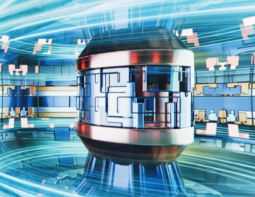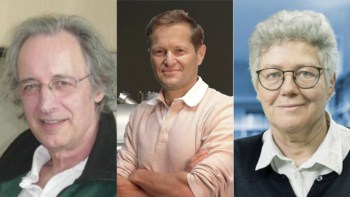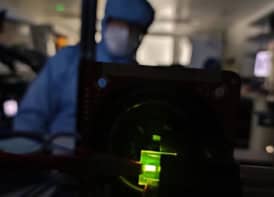
A gyroscope sensitive enough to detect Earth’s rotation has been created using a chip-based optical cavity. It was developed by Kerry Vahala and colleagues at Caltech in the US and its performance is currently on par with some commercial chip-based devices that use other measurement techniques. The team says that their design could be improved so that its sensitivity is tens or hundreds of times better than other chip-based gyroscopes – and with further effort, the technology could be adapted to create commercial devices.
Optical gyroscopes work on a physical principle called the Sagnac effect. Under laboratory conditions, optical gyroscopes are among the most sensitive devices available to measure rotation. The Rotational Motions in Seismology gyroscope in Germany, for example, can measure minute variations in Earth’s rotation rate.
“Imagine a ring with a clockwise and a counter-clockwise laser beam,” says Valhala. “If the ring is not rotating, then the round-trip time for the beams to come back to some fixed point on the perimeter is identical. But as you rotate the ring, then the round-trip time becomes different, and the difference is proportional to the rotation rate.”
“Hockey puck” of optical fibres
The effect can be enhanced – and thus the sensitivity of the gyroscope increased – by increasing the distance travelled by the light. This is often achieved by sending the light down a long coil of fibre-optic cable, producing a device that looks, says Vahala, “like a hockey puck”. Producing such a device on an integrated-circuit chip would be difficult or impossible according to Daniel Blumenthal of University of California, Santa Barbara – who is not a member of Valhala’s team.
A possible solution lies in an alternative type of optical gyroscope called a ring laser gyroscope. Instead of using a long coil of optical fibre, ring laser gyroscopes effectively send light waves in both directions repeatedly around the same circular laser cavity. “Rather than having to go around a physical length of 200 m or longer, you’re recycling the light and amplifying it through the lasing action,” explains Vahala. “It’s that recycling action through many round trips that gives ring laser gyroscopes their sensitivity.”
In principle, one could simply send laser light with identical frequencies in both directions around the same cavity. At zero rotation, there would be no beat frequency between the interfering waves, and the beat frequency would grow as the rotation rate increased.
Locked out
Unfortunately, in ring laser gyroscopes, the clockwise and anticlockwise frequencies tend to lock together, suppressing the Sagnac effect at low rotation rates. “Different techniques have been developed in commercial ring-laser gyroscopes over the decades, including mechanically rocking the device back and forth to unlock the frequencies and allow the measurement to proceed,” explains Valhala.
Now, Vahala’s team has developed a more elegant solution, injecting different clockwise and anticlockwise pump laser signals into the cavity. These create the ring-laser signals via a process called stimulated Brillouin scattering. This prevents the two laser signals from locking together and provides a non-zero beat frequency between the signals. Any additional rotation will change this beat frequency.
The researchers applied this technique in an optical gyroscope with a 36 mm ring laser cavity on a silicon chip. They set the device on an optical table and tilted it first North and then South, detecting a frequency difference equivalent to that expected from the rotation of the Earth.
Blumenthal comments, “People, including my group, have put laser gyros on chips before. But the hard part, which this paper overcomes, is breaking this lock-up around the zero point.” He adds, “Measuring Earth’s rotation rate is considered your standard of the best you can do at zero movement because if you can measure that you can measure any other rotation and then subtract out the Earth’s rotation rate.”
Important first step
Blumenthal points out that only the resonant cavity is on a chip – with the pump laser, detectors and other components external to the chip in a stabilized enclosure. However, creating the cavity on a chip is a crucial first step towards a fully on-chip technology. Vahala’s team concur that the technology is not ready for commercialization and are working on ways forward.

Underground ring lasers will put general relativity to the test
However, Vahala says that the group’s chief priority is increasing sensitivity. “There are little MEMS gyroscopes based on the Coriolis effect in cellphones, video games – anywhere you need a very low-cost way of measuring the orientation of something – and these are by far the most commercially successful gyroscopes ever,” he says.
“[Our] gyroscope is competitive with some of these MEMS devices – but why would anyone want to pay for the development of an optical gyroscope on a chip to obtain the same level of performance as a MEMS device? These Sagnac devices have the potential to offer much better performance and, at somewhere between a factor of ten and a factor of a hundred improvement, these devices would probably start to create their own separate application space.”
The laser cavity and Earth-rotation measurements are described in papers in Nature and Nature Photonics respectively.



